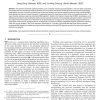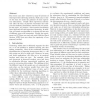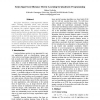11 search results - page 1 / 3 » Semi-Supervised Maximum Margin Clustering with Pairwise Cons... |
TKDE
2012
12 years 9 months ago
2012
—The pairwise constraints specifying whether a pair of samples should be grouped together or not have been successfully incorporated into the conventional clustering methods such...
SDM
2004
SIAM
14 years 8 months ago
2004
SIAM
Semi-supervised clustering uses a small amount of supervised data to aid unsupervised learning. One typical approach specifies a limited number of must-link and cannotlink constra...
JMLR
2010
14 years 1 months ago
2010
In this paper, we present an overview of generalized expectation criteria (GE), a simple, robust, scalable method for semi-supervised training using weakly-labeled data. GE fits m...
SDM
2008
SIAM
14 years 8 months ago
2008
SIAM
The recent years have witnessed a surge of interests of semi-supervised clustering methods, which aim to cluster the data set under the guidance of some supervisory information. U...
ICPR
2010
IEEE
15 years 1 months ago
2010
IEEE
This paper introduces a semi-supervised distance metric learning algorithm which uses pair-wise equivalence (similarity and dissimilarity) constraints to improve the original dist...



